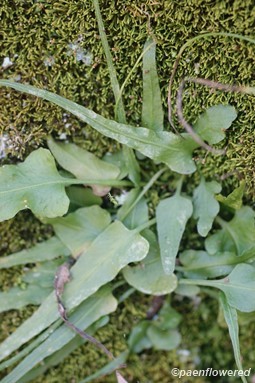Asplenium rhizophyllum
Quite rare and highly localized fern found in limestone soil
Asplenium rhizophyllum walking fern
Evergreen fern with simple, lanceolate fronds. Sori are numerous on the underside of leaves. Each tip may have an extension that takes root to form the next frond, a very unique propagation method. The species name 'rhyzophullum' refers to this walking pattern of the fern (from greek 'with rooting feet'). Fronds have strong, forked veins emerging from a prominently raised midrib.
Walking fern hybridizes with A. platyneuron (Ebony spleenwort) forming A. ebenoides (Scott's spleenwort).
Habitat & Range
Likes moss-covered faces of rocks, cliffs and boulders, particularly limestone; sometimes edges and crevices of moist outcroppings. Usually has northern exposure.
Occasionally, can be found on the ground or fallen trees covered with moss.
This fern is quite rare and localized, observed in all areas of the North-East where limestone soil is present.
Wetland code: Not classified
Phenology
This fern overwinters.
Tiny spores of the sori are released during the summer or fall and are distributed by wind.
Characteristics
Fertile fronds and sterile fronds are comparable in size (up to 15 in long and up to 2 in wide at the base). Sometimes fertile fronds can be a little larger than sterile fronds.
Blades overwinter, are slightly leathery, shiny green above and paler below, smooth, usually heart-shaped/eared at the base, triangular and tapering to a long, thin point. The margins can be wavy or indented, but always narrow, long and pointed when mature. Veins can sometimes be netted near the midrib, otherwise are strong and forked. The shape of the blade is simple(or entire).
Stipe slender, flattened of dark brown at the base and green and smooth above, the face is grooved.
Rhizome short, slender, and erect.
Sori oftentimes numerous and scattered irregularly throughout the blade at interceptions of veins; indusium not highly noticeable.
Identification Tips
The fern has a 'walking' growth pattern - roots form at the tip of the blade to produce the next frond or can form from the basal lobes of the frond.
Plant Codes
S-rank: S5 (Secure)
G-rank: G5 (Secure)
APG/Taxonomization Info
Walking fern was first described by Linnaeus in 1753.











Comments
Have you spotted this plant in your area? We'd love to hear about your experience! Share your comments or questions about the plant below. Comments are moderated before posting.